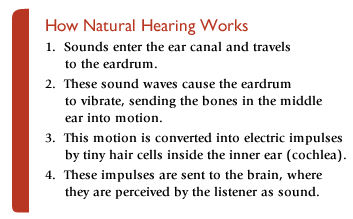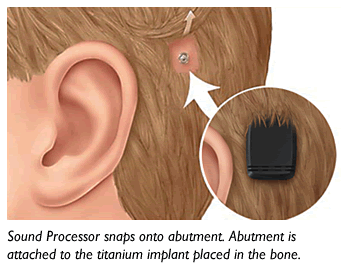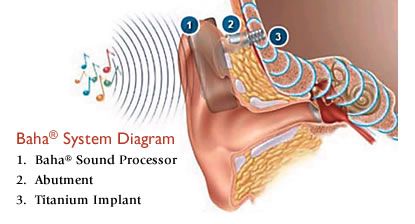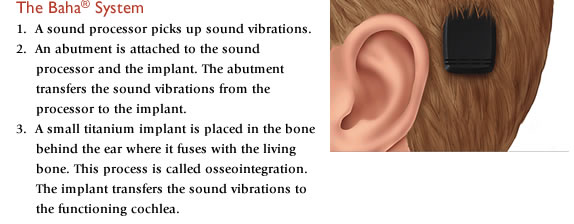Hearing—
How Important is it
to Your Everyday Life
Richard Crane, MD, FACS
Otolaryngology
Western Wisconsin Ear, Nose & Throat Center
Eau Claire
Our hearing is valuable and when we lose it, we look for answers to fix it. Whether it’s present at birth, or happens suddenly or gradually over time, hearing loss can leave you feeling isolated and separated from friends and family. There are several solutions available depending on your type of hearing loss.
One out of 10 Americans–approximately 32 million-experience some degree of hearing loss. Many people can treat their hearing loss with traditional hearing aids, while other degrees of hearing loss may require more advanced treatments. Baha® (Bone Anchored Hearing Aid) is an innovative technology that may help when hearing aids are not enough.

Types of Hearing Loss
Sensorineural Hearing Loss:
Sensorineural hearing loss (nerve deafness) occurs when there is damage to the inner ear (cochlea) or to the nerve pathways from the inner ear to the brain.
Conductive Hearing Loss:
Conductive hearing loss occurs when sound is not conducted efficiently through the outer ear canal, eardrum and the tiny bones of the middle ear.
Mixed Hearing Loss:
Sometimes a conductive hearing loss occurs in combination with a sensorineural hearing loss. There may be damage in the outer or middle ear and in the inner ear (cochlea) or auditory nerve.
 About Bone–Anchored Hearing Solutions
About Bone–Anchored Hearing Solutions
Bone-anchored hearing solutions are a proven medical option for adults and children with conductive hearing loss, mixed hearing loss, and single-sided sensorineural deafness meeting the candidacy criteria. The Baha® system sends external sounds to the inner ear through the bone bypassing the outer and middle ear. Bone anchored hearing solutions are designed to provide audibility and to improve the communication abilities of those who receive little or no benefit from hearing aids.
The Baha® system, which is based on bone conduction, utilizes a titanium implant, which is placed in the skull bone behind the ear. An abutment connects the sound processor with the implant in the bone. This creates direct (percutaneous) bone conduction.
Sound Processor snaps onto abutment. Abutment is attached to the titanium implant placed in the bone.
Who Can Benefit?
Instead of trying to send sound through the damaged areas of the ear, a Baha® system sends it through the bone, naturally stimulating the inner ear. While conventional air conduction and bone conduction hearing aids may provide a satisfactory solution for some people with the types of hearing loss listed below, they are not always suitable.
• Conductive Hearing Loss
• Mixed Hearing Loss
• Single Sided Deafness
4 Easy Steps
- Determine Hearing Profile – A thorough hearing test and ENT evaluation helps to identify the hearing profile and determines if you are a Baha® candidate. You may be offered a demonstration of a Baha® using the test unit.
- The Procedure – A qualified ENT surgeon performs the procedure and it is typically done in an outpatient setting with no risk of further hearing loss. Most people can resume normal activity within a few days.
- Fitting the Baha® – Once the implant has osseointegrated (typically 3 months), the patient is fitted with the external Baha® sound processor.
- Minimal Aftercare – Instructions for aftercare include keeping the implant and abutment clean and the sound processor dry.


What does the sound processor look like?
The Baha® Sound Processor snaps onto the abutment.
The processor is small, discreet and is available in a variety
of colors. The volume controls are conveniently located for
easy adjustments.
Reimbursement
Many insurance companies and health care systems are willing to reimburse Baha® treatment. Hearing aids are not typically covered by insurance companies. However, CMS with Medicare has determined that the Baha® is not a hearing aid. Medicare pays for the Baha® system. Insurance coverage from private payers still varies. We offer assistance with reimbursement issues through the Baha® company (Cochlear Americas) Insurance Support.
If you struggle with one of these types of hearing loss, we encourage you to take the next step by making an appointment for a comprehensive evaluation at our clinic. We are proud to
be the only Ear, Nose & Throat Clinic in the Eau Claire area to offer this treatment, and we are excited to help those who may benefit from it.
Dr. Crane –
Western Wisconsin Ear, Nose & Throat Center
For information or to schedule an appointment:
715-831-0289 | www.oakleafmedical.com
Dr. Crane sees patients in Eau Claire.